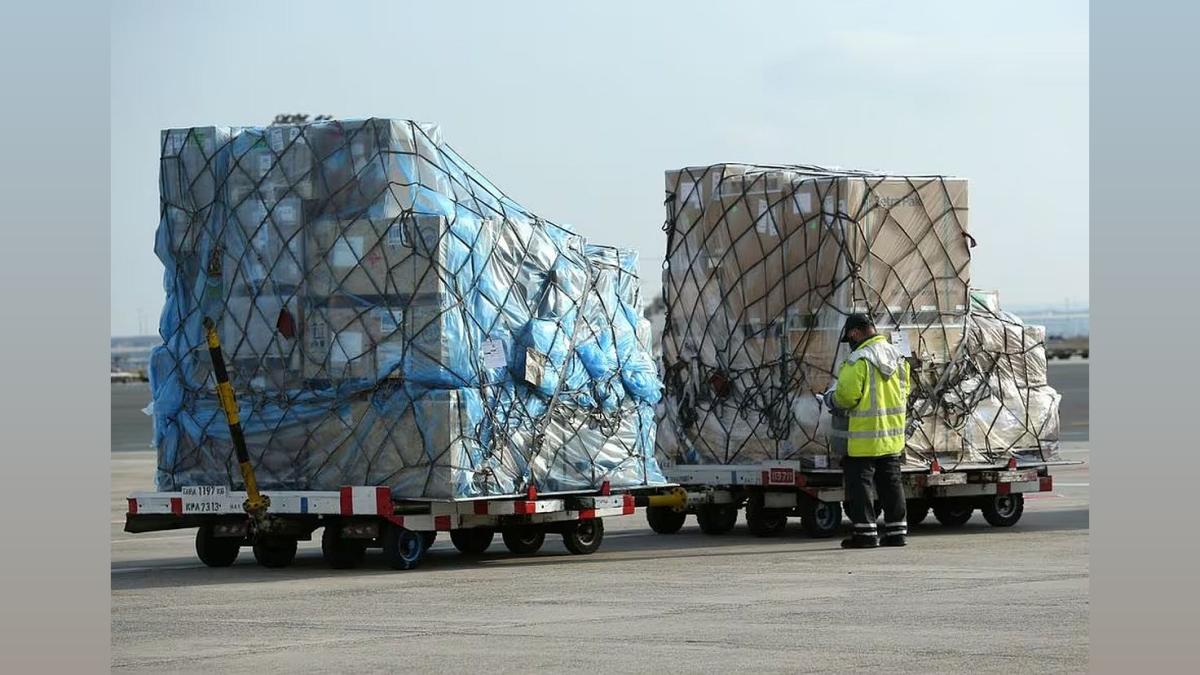Red Sea Tensions Impact India Exports: Freight, Insurance Costs Rise
Escalating tensions in the Red Sea are impacting India's exports due to increased freight costs and insurance premiums as shippers take longer routes. The Bab-el-Mandeb Strait, a crucial shipping route, has seen attacks by Yemen-based Houthi militants.

Photograph: Ralph Orlowski/Reuters
New Delhi, Jan 5 (PTI) Escalating tensions in the Red Sea have started impacting India's exports due to increasing freight costs and insurance premiums as shippers have to take longer routes to reach destinations like the US and Europe, an official said on Friday.
The situation around the Bab-el-Mandeb Strait, a crucial shipping route connecting the Red Sea and the Mediterranean Sea to the Indian Ocean, has escalated due to recent attacks by Yemen-based Houthi militants.
Due to these attacks, the shippers are taking consignments through the Cape of Good Hope, resulting in delays of almost 14 days and also higher freight and insurance costs.
The issues being faced by the concerned stakeholders were discussed at a high-level meeting in the commerce ministry on January 4.
Stakeholders, including traders, shippers, container firms and freight forwarders were there at the meeting.
"They told us that freight cost has increased. They have to take a long route now and due to that, the turnaround time has increased. It has increased by 14 days," the official said.
Exports to Europe, the east coast of the US and Latin America are facing problems.
Due to attacks, shipping lines have reduced their movement through the Red Sea and taking the longer route via the Cape of Good Hope, encircling the African continent.
"Insurance costs have also increased because they are not sure what (will) happen to the ships. Some consignments have passed through the long route. Some ships are also being escorted, provided by the government," the official added.
According to exporters, due to rising freight rates, some are postponing shipping their goods. Besides, the uncertainty may lead to a shortage of containers.
The increase in freight rates varies with the route. Apart from basic freight rates, risk surcharge and peak season surcharge have also shot up.
On Thursday, the Ministry of Commerce and Industry held a meeting to take stock of the impact of the crisis on Indian trade.
Officials of the Ministry of Ports, Shipping and Waterways also participated in the meeting, apart from representatives of the Container Shipping Lines Association, FIEO and other export promotion organisations.
"The meeting was for stocktaking to understand what exactly is happening and the issues they are facing," the official said.
Apart from exports, the disruption in imports can also create issues going ahead.
Importers are saying that they have an inventory for a month and after that, they will start facing issues if the situation does not improve.
A trade expert stated that every year about USD 100 billion of Indian exports pass through the Red Sea route, which translates to over USD 8 billion monthly.
"Even if 25 per cent of the exports are impacted by the problems in the Red Sea, it will mean an impact of around USD 3 billion this year. Even if attacks on merchant shipping stop, it will take some time for the situation to completely normalise.
"Around 60 ships pass the Suez Daily, and in the previous blockade by breakdown of a ship for six days in 2021, much time was taken for getting the situation back to normal," according to an expert.
The trade route of Bab-el-Mandeb Strait, the Suez Canal and the Red Sea is shorter and faster than the Cape of Good Hope route, making it the preferred option for most shipping companies.
The route starts from major Indian ports like Mumbai, JNPT, or Chennai, heads westward through the Arabian Sea, enters the Red Sea, and navigates through the Suez Canal into the Mediterranean Sea.
From there, ships can reach various European ports depending on their destination.
The Cape of Good Hope route is longer and slower than the Suez Canal route, but it avoids the potential for delays or disruptions at the Suez Canal.
It is typically used for bulk cargo shipments where time is less critical or when political instability in the Middle East raises concerns about using the Suez Canal.
The route starts from the same Indian ports, heads southward across the Indian Ocean, rounds the Cape of Good Hope at the southern tip of Africa, and then sails northward along the west coast of Africa before entering the Mediterranean Sea and reaching European ports.
The situation around the Bab-el-Mandeb Strait, a crucial shipping route connecting the Red Sea and the Mediterranean Sea to the Indian Ocean, has escalated due to recent attacks by Yemen-based Houthi militants.
Due to these attacks, the shippers are taking consignments through the Cape of Good Hope, resulting in delays of almost 14 days and also higher freight and insurance costs.
The issues being faced by the concerned stakeholders were discussed at a high-level meeting in the commerce ministry on January 4.
Stakeholders, including traders, shippers, container firms and freight forwarders were there at the meeting.
"They told us that freight cost has increased. They have to take a long route now and due to that, the turnaround time has increased. It has increased by 14 days," the official said.
Exports to Europe, the east coast of the US and Latin America are facing problems.
Due to attacks, shipping lines have reduced their movement through the Red Sea and taking the longer route via the Cape of Good Hope, encircling the African continent.
"Insurance costs have also increased because they are not sure what (will) happen to the ships. Some consignments have passed through the long route. Some ships are also being escorted, provided by the government," the official added.
According to exporters, due to rising freight rates, some are postponing shipping their goods. Besides, the uncertainty may lead to a shortage of containers.
The increase in freight rates varies with the route. Apart from basic freight rates, risk surcharge and peak season surcharge have also shot up.
On Thursday, the Ministry of Commerce and Industry held a meeting to take stock of the impact of the crisis on Indian trade.
Officials of the Ministry of Ports, Shipping and Waterways also participated in the meeting, apart from representatives of the Container Shipping Lines Association, FIEO and other export promotion organisations.
"The meeting was for stocktaking to understand what exactly is happening and the issues they are facing," the official said.
Apart from exports, the disruption in imports can also create issues going ahead.
Importers are saying that they have an inventory for a month and after that, they will start facing issues if the situation does not improve.
A trade expert stated that every year about USD 100 billion of Indian exports pass through the Red Sea route, which translates to over USD 8 billion monthly.
"Even if 25 per cent of the exports are impacted by the problems in the Red Sea, it will mean an impact of around USD 3 billion this year. Even if attacks on merchant shipping stop, it will take some time for the situation to completely normalise.
"Around 60 ships pass the Suez Daily, and in the previous blockade by breakdown of a ship for six days in 2021, much time was taken for getting the situation back to normal," according to an expert.
The trade route of Bab-el-Mandeb Strait, the Suez Canal and the Red Sea is shorter and faster than the Cape of Good Hope route, making it the preferred option for most shipping companies.
The route starts from major Indian ports like Mumbai, JNPT, or Chennai, heads westward through the Arabian Sea, enters the Red Sea, and navigates through the Suez Canal into the Mediterranean Sea.
From there, ships can reach various European ports depending on their destination.
The Cape of Good Hope route is longer and slower than the Suez Canal route, but it avoids the potential for delays or disruptions at the Suez Canal.
It is typically used for bulk cargo shipments where time is less critical or when political instability in the Middle East raises concerns about using the Suez Canal.
The route starts from the same Indian ports, heads southward across the Indian Ocean, rounds the Cape of Good Hope at the southern tip of Africa, and then sails northward along the west coast of Africa before entering the Mediterranean Sea and reaching European ports.
You May Like To Read
TODAY'S MOST TRADED COMPANIES
- Company Name
- Price
- Volume
- Vodafone Idea L
- 8.23 (+ 1.60)
- 120450353
- Standard Capital
- 0.55 (+ 3.77)
- 26234194
- AvanceTechnologies
- 0.64 (+ 18.52)
- 15503509
- G G Engineering
- 0.97 (+ 7.78)
- 14312441
- Sharp Investments
- 1.14 (+ 20.00)
- 10870953







 © 2025 Rediff.com India Limited. All rights reserved.
© 2025 Rediff.com India Limited. All rights reserved.